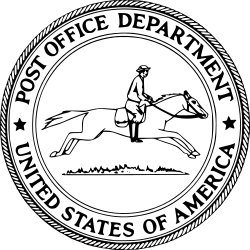James Albert Gary
| James Albert Gary | |
|---|---|
 | |
| 38th United States Postmaster General | |
|
In office March 5, 1897 – April 21, 1898 | |
| President | William McKinley |
| Preceded by | William L. Wilson |
| Succeeded by | Charles Emory Smith |
| Personal details | |
| Born |
October 22, 1833 Uncasville, Connecticut |
| Died | October 31, 1920 (aged 87) |
| Profession | Politician, Businessman |
James Albert Gary (October 22, 1833 – October 31, 1920) was a U.S. political figure. Gary ran as the Republican candidate for Maryland Governor in 1879, losing to William Thomas Hamilton.[1] He served as the Postmaster General between 1897 and 1898. He married Lavinia Washington in 1856. They had ten children with only eight surviving to adulthood.[2] He spent much of his working life in textile manufacture in the Baltimore, Maryland, region, and was involved with cotton mills along the Patapsco and Patuxent Rivers, including Ely, Guilford, and Laurel, Maryland.
Gary was a prominent member of Baltimore's prestigious Brown Memorial Presbyterian Church and led the movement to establish Babcock Memorial Church there in memory of Brown Memorial's minister, Maltbie Babcock.[3] He also contributed to the construction of a church in Daniels, MD, which was later named in his honor: Gary Memorial United Methodist Church.[4]
Gary had a home in the Mount Vernon section of Baltimore and a summer place in Catonsville.
References
- ↑ "Maryland-Colored voters shot down and driven away from the polls". The New York Times. 5 November 1879.
- ↑ "James Albert Gary Biography". Twentieth Century Biographical Dictionary of Notable Americans 1904.
- ↑ "In memory of Dr. Babcock" (PDF). The New York Times. May 24, 1901. Retrieved December 6, 2008.
- ↑ Gary Memorial United Methodist Church; http://gmuc.org/history.asp
External links
James Albert Gary at Find a Grave
| Political offices | ||
|---|---|---|
| Preceded by William L. Wilson |
United States Postmaster General Served under: William McKinley 1897 – 1898 |
Succeeded by Charles Emory Smith |
